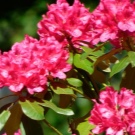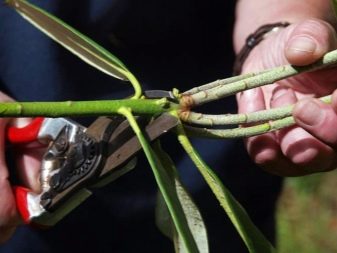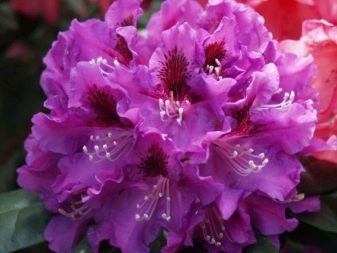Hybrid rhododendron: characteristics of varieties and rules of care

Hybrid rhododendron is a plant striking in its diversity and beauty, which has up to 600 species. The name consists of two words: "rhodon" - pink and "dendron" - tree, which means "rosewood". They grow mainly in mountainous areas in many parts of the world, preferring moist acidic soils and the shade of trees, especially in coniferous forests. They are evergreen and deciduous. There are about 18 species in Russia, and more often they are frost-resistant.
Description
The flowers impress with their palette of shades: pink, white, lilac, purple, orange, yellow, and in the middle with specks of a darker and brighter shade. The shapes are also different: flattened, bell, tube. The crown is in the form of a ball, elongated upward or horizontally, and the rhododendron grows this way without assistance. Bushes and trees have leaves of a dark green color, dense and shiny, resembling a lancet. Cultivars that shed their foliage in autumn have a rich orange, sometimes red color. The root system is fibrous, small.






Care
Many people consider rhododendrons to be demanding to care for, but this is not so. The main thing is to create suitable growing conditions.
- Landing. Can be planted both in early spring and autumn, but not late. Also, do not do this during flowering or late autumn. The transplant can be carried out at any period of growth and at any time of the season, except for flowering and late autumn. To plant a seedling, a hole is dug 40-50 cm deep and 60 cm in diameter and a plant with an earthen lump is transferred into it.
- Light. The Rosewood tree needs a properly lit location more than others. Young specimens should grow in a sunny location with light partial shade. And for adults, more shaded places, but letting in the sun's rays, are suitable, for example, from the north side.
- Priming. Acidic soils with peat, coniferous litter, clay, sand and well-drained soils are preferred.
- Top dressing... Both liquid and granular acidic fertilizers are suitable. Some species require soil mulching. You should not use a hoe when weeding, you need to remove the weed with your hands, this will protect the root system from damage.
- Watering... In the summer, frequent soil moisture is needed so that the soil is saturated by 20-30 cm, since peat dries up very much. When it rains, it is canceled. If the rhododendron is not planted in open ground, but in a container (also applies to those plants that are planned to be transplanted), then you need to lower it into the water until air bubbles go. Do not fill in, the roots may begin to rot.
- Wintering. For the winter, it is necessary to cover, cut and tie the branches so that they do not break under the weight of the snow. It is better to remove the shelter when a stable temperature of at least +5 degrees is reached.
- Pruning... After flowering, you need to cut off all shoots by 1/3 or ½, remove all dry inflorescences.


Varieties
All of the shrubs listed below are evergreen, winter-hardy plants. They are suitable for the middle zone of our country.
"Azurro"
Shrub up to 1.2 meters high, withstands frosts down to -23 degrees. It appeared as a result of crossing the varieties "Nova Zembla" and Purple Splendour. At an early age, pruning of shoots is required for lush flowering in the future. The flowers are large in diameter - 10-12 cm, the flowering of which occurs at the end of May.They are purple in color, with a wavy edge and burgundy specks. For the winter, the plant must be covered


"Nova zembla"
The height of an adult plant is 1.8 m, and its diameter is 2 m, and in warm climates the rhododendron grows up to 3 meters. The leaves are oval, large, up to 16 cm. Named after the place where this variety was bred - Novaya Zemlya. Obtained by free pollination of Katevbinsky rhododendron in 1902. The branches of the shrub are directed upwards. The flowers are red with black dots in the center and on the upper petal. It is frost-resistant, can withstand temperatures down to -32 ° C. In severe winters, it requires shelter.


Cunninghams White
This variety was first introduced for cultivation in the northern strip. It can be considered the most beautiful among all hybrids. It has pink buds, which, when opened, turn into beautiful white lush inflorescences with a pale pink heart and golden specks. The shrub is distinguished by its spreading. Large, up to 12 cm, leaves of a dark green color, elliptical in shape. The size of an adult plant reaches 1.5 m in the crown and 2 m in height. Withstands temperatures down to -28 -30 ° C. But in more severe frosts it can freeze.
It also needs a place protected from winds and open sun. A hybrid was bred in 1850.


Helsinki University
Perhaps the most frost-resistant, withstands frosts down to -39 ° C. It grows up to 1.5-1.7 m in height and a compact crown of 1-1.5 m.The leaves are dark, glossy, large, up to 15 cm long and up to 6 cm wide. the second half of June and delight with their beauty for up to 3 weeks. Inflorescences are collected from 12-15 flowers at the crown of the shoots, forming pale pink caps.


"Purpureum Grandiflorum"
A bush with spherical purple inflorescences at the tops of branches, reaches a height of 2.5 m, and a crown - 2.7 m. Needs mulching of the soil. Due to its branchiness, it requires protection from the wind, as well as from the drying sun. Winter-hardy - withstands frosts down to -30 ° C. The leaves are dark green above and grayish below, medium size, only up to 8 cm long, oval in shape. The inflorescences are collected in balls of 15 flowers, the size of one flower is 6-7 cm. The flowers are of a more intense shade compared to the predecessor, the Grandiflorum rhododendron.


Roseum Elegance
Tall, spreading shrub up to 3 m in height and 3.5 m in the crown. It resembles a small tree. Blooms from early June to 3 weeks. The flowers resemble lilac-pink lilies, with a dark speck on the top petal and a speck in the middle. Their size is 5-7 cm, collected in inflorescences of 15 pieces. Capable of surviving frosts up to 32 ° C.
It is necessary to protect the plant from winds and burning sunlight.


"Sappho"
A beautifully flowering shrub up to 2 m in height and in diameter. Snow-white flowers with black currant-colored specks on the upper petal bloom from delicate lilac buds pointed upwards. It does not differ in resistance to cold, it can withstand temperatures down to -20 ° C, so you need to cover the plant for the winter. Dark green lancet-shaped leaves. It prefers to grow in partial shade, but not strong, as the crown can grow strongly.
One of the first varieties brought to Europe was the Katevbinsky rhododendron. It grows by 10-12 cm per year, at the age of 10 years it has a height of 1.5 m, but can reach from 2 to 4 m, the crown exceeds its growth in diameter. Flower petals can be either oval or pointed, pink in color, collected in inflorescences of 15-20 pieces and a size of 12-15 cm. This variety is used for breeding varieties with high cold resistance.
If you decide to decorate your personal plot with something special, then feel free to choose these marvelously flowering shrubs, some of them can delight with their flowering 2 times per season.


How to care for rhododendron at home, see below





































































































The comment was sent successfully.